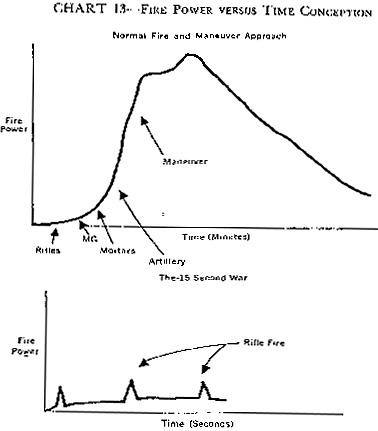EDITOR'S NOTE: Modern rules buffs will be interested in the following excerpt from a 1974 Army manual on Vietnam studies. It indicates that the majority of modern firefights took place at close range, 75 feet or less, presumably because of the dense jungle terrain.
The 15-Second War
 When snipers came into their own, it became apparent that aimed rifle fire was killing Viet Cong. In thinking about this, the thought occurred that the Viet Cong basically could not shoot and our men could. By that time (December 1968) the Viet Cong were beginning to fragment and we had many contacts which were essentially meeting engagements between small groups of men. By polling the commanders, it was found that the contact ranges were much closer than we had imagined in such open terrain-on the order of 10 to 25 meters.
When snipers came into their own, it became apparent that aimed rifle fire was killing Viet Cong. In thinking about this, the thought occurred that the Viet Cong basically could not shoot and our men could. By that time (December 1968) the Viet Cong were beginning to fragment and we had many contacts which were essentially meeting engagements between small groups of men. By polling the commanders, it was found that the contact ranges were much closer than we had imagined in such open terrain-on the order of 10 to 25 meters.
We then decided, more on faith than conviction, that we would go for aimed shot kills rather than fire superiority. We devised a very simple training drill to teach men to shoot under these conditions:
- a. Quick kill technique
b. Short range
c. Single aimed shots (quick kill)
d. No full automatic mode
e. Quick reaction (seconds)
The battalion commander, after an informal poll of riflemen, would determine what his normal opening range was and how quickly a soldier must fire to beat the enemy to the draw. We will say that a battalion commander set 25 meters and 8 seconds as his criteria. Each company, every third or fourth day during stand-down, would have the riflemen shoot at anything (tin cans, targets, whatever) until they could get a first round hit at 25 meters in 8 seconds.
By repetition, this became an automatic reflex action. This one idea in combination with good night ambushes made it possible for our small rifle units to wreak heavy damage on the enemy with low friendly casualties. One reason it worked so well was that the average Communist soldier was not trained to shoot and could not afford to expend the ammunition necessary to learn.
Actually this concept which was formulated at division level received more or less attention and implementation at lower levels, depending upon the commanders involved. However, there appeared to be some key element which was helpful. Nevertheless, it is one of the best examples we can think of which combined an analytical approach, military judgment, training, execution and substantial results. This idea has been termed the "15-Second War." Chart 13 shows why.
It seemed absolutely incomprehensible that some hundreds of riflemen wandering around could inflict heavy losses on a Communist enemy and seldom use the artillery, bombs, and so forth that were necessary in more formal warfare. (Naturally, if one hit a bunkered position, one shifted to heavy firepower.) However, this idea paid off manyfold on the battlefield in the Upper Delta and III Corps area during all of 1969.
Back to PW Review January 1981 Table of Contents
Back to PW Review List of Issues
Back to MagWeb Master Magazine List
© Copyright 1981 by Wally Simon
This article appears in MagWeb.com (Magazine Web) on the Internet World Wide Web.
Other articles from military history and related magazines are available at http://www.magweb.com